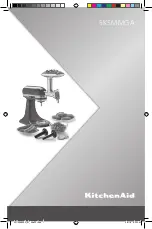
14
LUBRICATION FOR GROVE GEAR REDUCER
1.
Factory Filling
The speed reducers are oil filled at the factory to the proper level for the standard mounting position. The oil level
should be checked and adjusted (if necessary) prior to operation, using the oil level plug provided and while the unit is
oriented in its operating position.
2. Oil Changing
OIL SHOULD BE CHANGED MORE OFTEN IF THE
REDUCER IS USED IN A SEVERE ENVIRONMENT
(i.e., DUSTY, HUMID)
Therefore, when changing to a different oil, it is recommended that the housing be completely drained and thoroughly
flushed with a light flushing oil prior to refilling with the appropriate lubricant. The oil level should be rechecked
after a short period of operation and adjusted, if necessary.
A. Initial Oil Change
The oil in a new speed reducer should be changed at the end of 250 hours of operation. (30 days for 8 hour per day
service, 15 days for 16 hour service, 10 days for 24 hour service.)
All standard reducers ordered from the factory are filled with lubricant to operate within a 30° to 100° F ambient
temperature range.
B. Subsequent Oil Changes
Under normal conditions, after the initial oil change, the oil should be changed after every 2500 hours of operation,
or every six months, whichever occurs first. Under severe conditions (rapid temperature changes, moist, dirty, or
corrosive environment) it may be necessary to change oil at intervals of one to three months. Periodic examination
of oil samples taken from the unit will help establish the appropriate interval.
C. Synthetic Oils
3. Overfilling or Underfilling
If a speed reducer is overfilled with oil, the energy in churning the excessive oil can result in overheating. If this occurs,
shut down the drive, remove the oil level plug and allow oil to drain until oil ceases to drain from the level hole,
reinstall the oil level plug and restart the drive. If the speed reducer is underfilled, the resultant friction can cause
overheating and possible damage. If this occurs, fill the speed reducer to the oil level plug hole and check the gearing
for excessive wear. NOTE: Oil capacity is 1¾ pints.
4. Oil Seals
A. When installing a new seal, cover the keyway and any other surface discontinuity with smooth tape to protect the
seal lip from being damaged.
B. A sealant should be used between the O.D. of the seal and the I.D. of the bore into which the seal is installed. The
seal bore should also be free of any burrs, nicks, or scratches.
C. Be sure that the seal is not cocked in the bore. The outer face of the seal should be flush with the surface into which
it is mounted.
WHEN CHANGING OIL FOR ANY REASON,
DO NOT MIX DIFFERENT OILS IN THE REDUCER.
OILS SHOULD BE COMPATIBLE WITH
VITON SEAL MATERIAL.
®
Synthetic lubricants can be advantageous over mineral oils in that they generally are more stable, have a longer life,
and operate over a wider temperature range. These oils are appropriate for any application but are especially useful
when units are subjected to low start-up temperatures or high operating temperatures. Use of synthetics can cause
problems if they are not compatible with the seals or the conventional lubricants they replace. For continuous duty
at normal ambient temperatures (-10° to 105°F) we recommend the use of Mobile SHC 634 which is compatible
with the standard compounded oil shipped in our product and the Viton seal material used through size 252.
®
Although the speed reducer uses high quality oil seals and precision ground shafts to provide a superior seal contact
surface, it is possible that circumstances beyond the speed reducer’s control can cause oil seal leakage (damage during
shipment or installation, etc.) When replacing a shaft oil seal, using the following suggestions will help to insure leak-
free operation and long seal life:
Summary of Contents for EMG-32
Page 14: ...12 OPERATOR S NOTES ...
Page 21: ...19 MIXING PADDLE HISTORY BY SERIAL NUMBER ...
Page 23: ...21 ...
Page 24: ...22 ...
Page 26: ...24 ...
Page 27: ...25 ...
















































